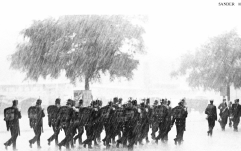The Key to Understanding
Business Cycles
(Tide Press)
 Zahorchak is of the Multiple Repetition School of economic writing: saying it once is good, twice better; thirty-four times best of all. He attempts to prove that there are cycles in the weather that influence the quality of national leadership, energy of the peoples, risings and failings of civilizations, and cycles on the commodities and stock markets.
Zahorchak is of the Multiple Repetition School of economic writing: saying it once is good, twice better; thirty-four times best of all. He attempts to prove that there are cycles in the weather that influence the quality of national leadership, energy of the peoples, risings and failings of civilizations, and cycles on the commodities and stock markets. There are some interesting facts sprinkled about here, raisins in the plum pudding. Most large cities (above 100,000 population) are located at 53° to 55° latitude, and many of them have a mean annual temperature of 46 - 50° Much of France is north of Minneapolis, but there is no Michelin Guide to the restaurants of Minneapolis.
Philadelphia and Madrid are roughly at the same latitude; so are Mexico City and Rangoon. India has only 180 people per square mile, whereas Germany has more than double that. Australia and Bolivia have the least population density, the former having two people per square mile, some of whom have not actually backpacked around the globe.
Verkhoyansk, Siberia has the greatest absolute temperature range in the world...that is, outside (or inside) the bathroom of our apartment (94° F. during the summer, 94° below zero in the winter). In Boston, the range is 140 degrees, and San Francisco, 65 degrees.
The year-round hottest temperature average was in our Aunt Ada's sitting room, where she made us kids stay seated, fully dressed, sweating for hours as she told us about how to Stay Right with God.
- Most civilized areas on earth enjoy a specific type of rainfall --- the cyclonic storm...wind, moderate to strong changes in temperature, and moderate to strong changes in barometric pressure...
The other basic forms of rainfall are (1) the Mediterranean ("precipitation... largely confined to winter and spring and... followed by a long summer drought..."); (2) the monsoon: in summer, high humidity and rainfall, and in winter, cold, dry winds; and (3) the cloudburst that occurs in most parts of the Western world just after you get to bed and realize all the car windows are still open.
Zahorchak is at his best giving us interesting facts --- but when he gets around to discussing seven to 1,000 year cycles, or the "Golden Ages of History," it gets weird. For example, he sees the 13th Century, with Genghis Khan and his merry band of vandals and pillagers, as being a "Golden Age." Then there is his view of the political and social prospects for the rest of the 20th Century which are a bit vague around the sages. His final prediction of prosperity (perhaps) or slight depression (perhaps) or "possible limited economic progress" might, by some, be considered a modified limited cop-out. Or a crop-out.